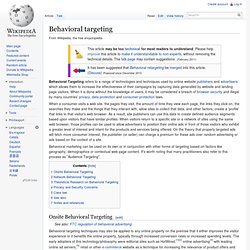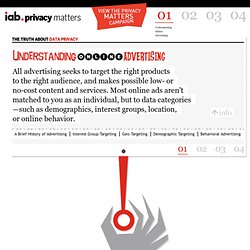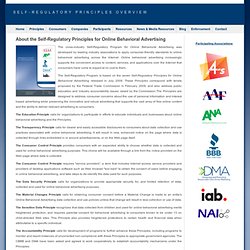

Behavioral targeting. Behavioral Targeting refers to a range of technologies and techniques used by online website publishers and advertisers which allows them to increase the effectiveness of their campaigns by capturing data generated by website and landing page visitors.

When it is done without the knowledge of users, it may be considered a breach of browser security and illegal by many countries' privacy, data protection and consumer protection laws. When a consumer visits a web site, the pages they visit, the amount of time they view each page, the links they click on, the searches they make and the things that they interact with, allow sites to collect that data, and other factors, create a 'profile' that links to that visitor's web browser. As a result, site publishers can use this data to create defined audience segments based upon visitors that have similar profiles. Onsite Behavioral Targeting[edit] Network Behavioral Targeting[edit] Web bugs. A web bug is an object that is embedded in a web page or email and is usually invisible to the user but allows checking that a user has viewed the page or email.[1] Common uses are email tracking and page tagging for web analytics.

Alternative names are web beacon, tracking bug, tag, or page tag. Common names for web bugs implemented through an embedded image include tracking pixel, pixel tag, 1×1 gif, and clear gif.[2] When implemented using JavaScript, they may be called JavaScript tags. Web bugging is analogous to conventional bugging, but is not as invasive or intrusive. The term should not be confused with the more benign web spider nor more malicious computer worms. Overview[edit] A web bug is any of a number of techniques used to track who is reading a web page or email, when, and from which computer.
Regulation of Behavioral Advertising. The targeted Internet advertising phenomenon is viewed with growing concern by privacy advocates who fear that controversial practices like behavioral tracking are ripe for abuse.

A coalition of consumer and Internet rights groups have written a joint open letter addressed to the House Committee on Energy and Commerce in which they articulate some specific concerns about behavioral tracking and provide an outline of proposed regulatory guidelines that they believe should be enforced to protect consumers. Behavioral tracking, a practice that is used by all of the major Internet advertising networks, involves building a profile of information about users based on which websites they visit. This information helps ad companies display advertisements that are more narrowly targeted to the interests of individual users. The Network Advertising Initiative. The Interactive Advertising Bureau. Privacy Matters. For as long as there’s been advertising, advertisers have aimed to target their ads to the right audience. targeting Beer ads during football games, cosmetics in women's magazines, trailers for coming attractions in the theaters — these are all examples of advertisers targeting products and services to what they hope is the most suitable audience.Internet technology has since created new and sophisticated ways to target “the right message to the right person at the right time.”Today cookies are the tools that give advertisers insight.

Before you worry about loss of privacy, remember that you have the choice to turn off targeting practices filtering cookies with your browser or opt out at Advertisers target ads by gauging the content you show interest in—including the sites you visit and the ads you click. examples When you go online, your Internet service provider (ISP) assigns your computer with a unique Internet Protocol (IP) address—such as 70.23.239.103. How it works As you surf. Digital Advertising Alliance. The Digital Advertising Alliance (DAA) is a consortium of the leading national advertising and marketing trade groups who together deliver effective, self-regulatory solutions to online consumer issues.

Participating associations include: Self-Regulatory Principles for OB Advertising. The cross-industry Self-Regulatory Program for Online Behavioral Advertising was developed by leading industry associations to apply consumer-friendly standards to online behavioral advertising across the Internet.

Online behavioral advertising increasingly supports the convenient access to content, services, and applications over the Internet that consumers have come to expect at no cost to them. The Self-Regulatory Program is based on the seven Self-Regulatory Principles for Online Behavioral Advertising released in July 2009. DAA's Central Opt-Out Page (86 Companies) eXelate Preferences Manager. eXelate believes that consumer control is key to delivering a great browsing experience.

The data shown represents the information gathered based on the activity of this computer – not an individual user. This page is designed to give you, the consumer, transparency into the information marketers have discovered about your interests through eXelate’s service. To get a snapshot of what our marketing partners have defined as your interests, simply review the sections below. By updating the information below, you will be opting in or out of receiving specific types of targeted ads. We never collect any personally identifiable information, so any interests noted will be totally anonymous.
If you prefer to have an untargeted ad experience while you surf, simply click the “Opt Out” button and all of your preferences will be cleared. Microsoft Advertising: Preferences. Google - Ad Preferences Manager.